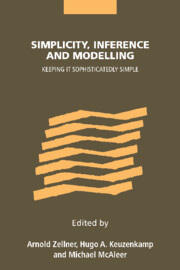Book contents
- Frontmatter
- Contents
- List of figures
- List of tables
- List of contributors
- 1 The enigma of simplicity
- PART I The importance of simplicity
- PART II Simplicity in theory and practice
- 8 Simplicity, information, Kolmogorov complexity and prediction
- 9 Simplicity and statistical inference
- 10 Rissanen's theorem and econometric time series
- 11 Parametric versus non-parametric inference: statistical models and simplicity
- 12 The role of simplicity in an econometric model selection process
- 13 Simplicity in a behavioural, non-parametric context
- 14 Keep it sophisticatedly simple
- 15 Communication, complexity and coordination in games
- 16 The simplicity of an earnings frontier
- 17 Simplicity: views of some Nobel laureates in economic science
- Index
15 - Communication, complexity and coordination in games
Published online by Cambridge University Press: 22 September 2009
- Frontmatter
- Contents
- List of figures
- List of tables
- List of contributors
- 1 The enigma of simplicity
- PART I The importance of simplicity
- PART II Simplicity in theory and practice
- 8 Simplicity, information, Kolmogorov complexity and prediction
- 9 Simplicity and statistical inference
- 10 Rissanen's theorem and econometric time series
- 11 Parametric versus non-parametric inference: statistical models and simplicity
- 12 The role of simplicity in an econometric model selection process
- 13 Simplicity in a behavioural, non-parametric context
- 14 Keep it sophisticatedly simple
- 15 Communication, complexity and coordination in games
- 16 The simplicity of an earnings frontier
- 17 Simplicity: views of some Nobel laureates in economic science
- Index
Summary
Introduction
This chapter investigates how the transmission of information determines collective behaviour in coordination games. Pre-play communication should help players to avoid coordination failures. Furthermore, transmission of information should help players to optimize their collective behaviour. Does this mean that pre-play communication guarantees successful coordination? Moreover, does pre-play communication favour Pareto-optimal Nash equilibria in the underlying game?
Most coordination games that are studied in the game-theoretic literature exhibit multiple strict Nash equilibria. While intuition might suggest that players should be able to coordinate in a Pareto-optimal equilibrium, the traditional refinements in game theory fail to select an efficient outcome. Still worse, they even fail to select a unique outcome. All strict equilibria survive even the strongest refinements. This conflict between intuition and formal analysis has given birth to several efforts among game theorists.
The first approach allows agents to send costless pre-play signals before they choose actions. This costless pre-play communication is called cheap talk. Unfortunately, cheap talk does not help players to coordinate in the efficient outcome. There exist equilibria in which players have decisions rules that are constant and therefore unaffected by the message received from the other players (cf. Weibull, 1995, p. 61). Hence, both problems of coordination, i.e. the problem of equilibrium selection and the problem of social inefficiency, remain unsolved.
- Type
- Chapter
- Information
- Simplicity, Inference and ModellingKeeping it Sophisticatedly Simple, pp. 263 - 276Publisher: Cambridge University PressPrint publication year: 2002



